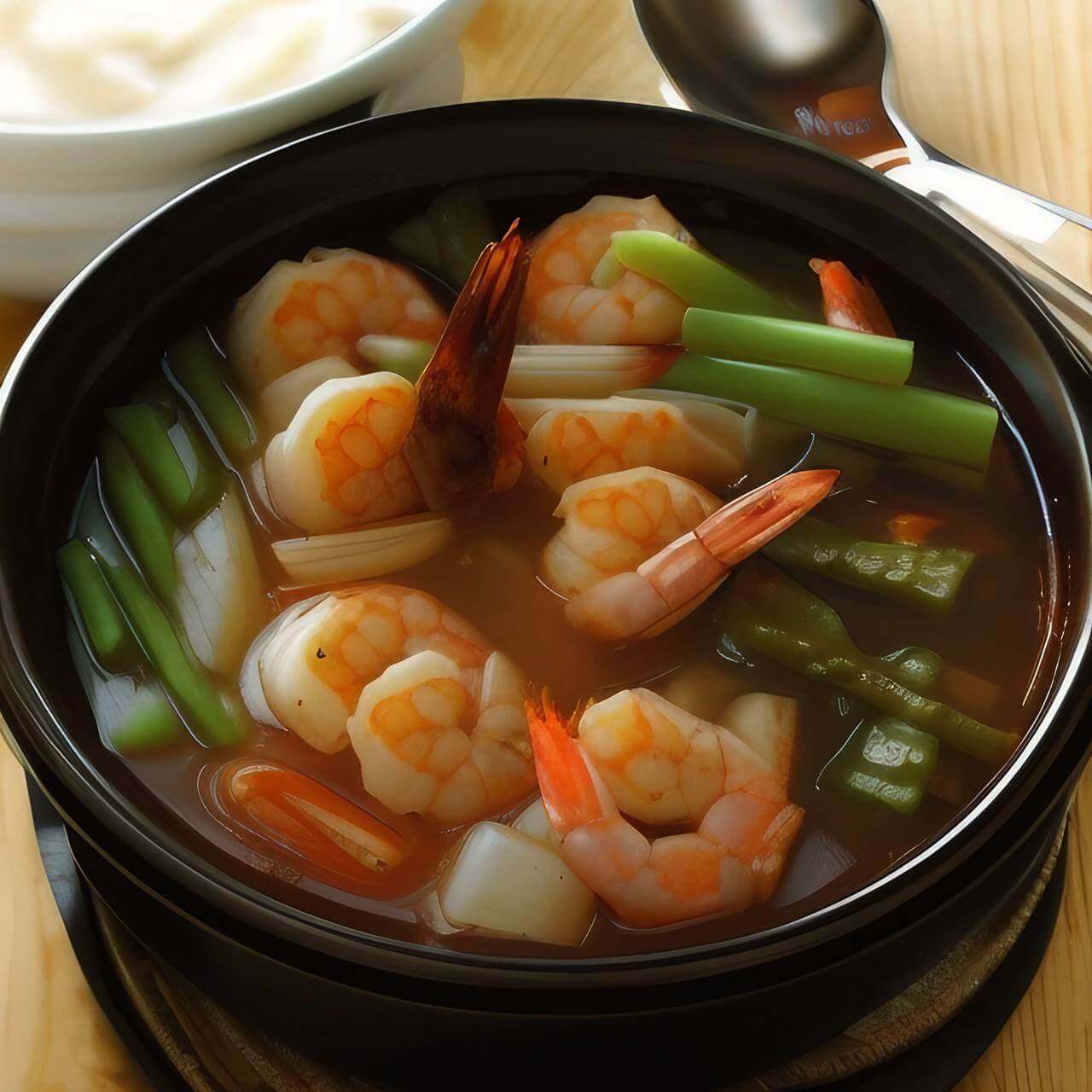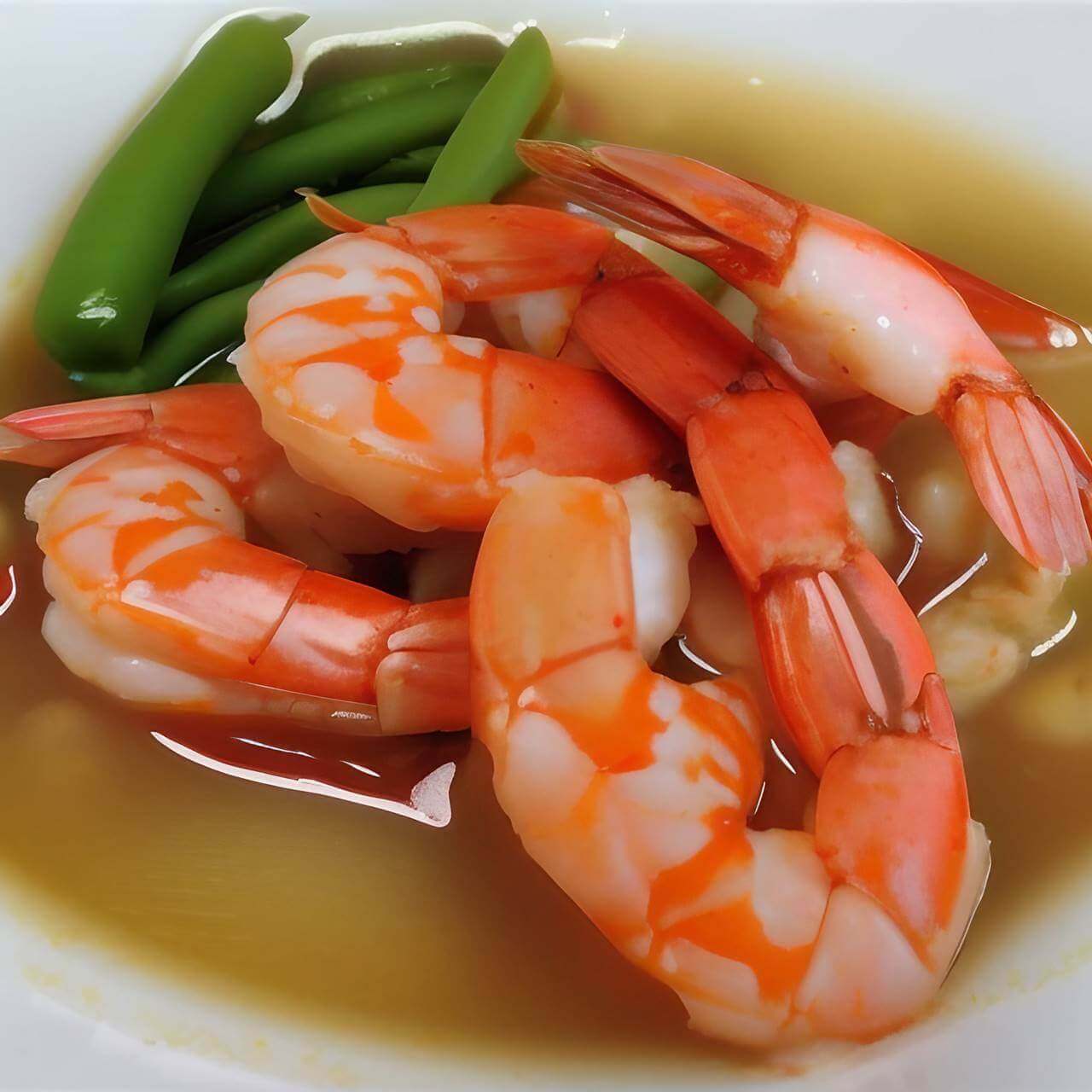Rich, restorative flavors in a bowl of steaming Sinigang can provide balm to the soul. Whether you believe that Grandmothers’ ancient wisdom holds true or not, one sip from this well-seasoned shrimp sinigang will open any blocked nasal passage. Sinigang is so beloved by locals that it’s even gaining global recognition, rivaling Adobo itself!
Savory and tart, sinigang is an iconic Filipino dish that showcases tantalizing meats cooked in a delectable soup. The special sourness of this stew originates from the plentiful fruits growing throughout the Philippines, with tamarind being one of its most popular ingredients to impart flavor into many sinigang recipes. Cozy up to a bowl of Sinigang na Hipon, the nourishing and comforting Filipino soup!
Also Read: How to Cook Filipino Chicken Sotanghon Soup
Featuring shrimp as its main course, this sour broth is filled with a delightful mix of vegetables such as daikon radish, snake beans, okra and eggplant. When the temperatures drop, nothing warms up your family like a hot bowl of Sinigang!
This savory dish is best served with steamed white rice and includes an array of delectable ingredients such as green mangoes, santol (lolly fruit), calamansi, guava, and more. Your family won’t be disappointed. The Filipino dish Sinigang na Hipon offers a unique twist on the traditional recipe, featuring different souring agents and proteins. Additionally, some chefs even add miso to the mix with fish as their primary ingredient. Regardless of the protein used, Sinigang na Hipon always makes for a delicious and comforting dish that can be enjoyed any time of year! So, let’s get cooking! Start by prepping the ingredients.

Ingredients
- A full liter of water.
- 3 medium ripe tomatoes – cut into quarters
- 1 medium onion (yellow or red) – cut into quarters
- 1 medium radish (labanos) – cut into slices
- 750 grams large shrimp
- Immerse yourself in the bold flavors of Sinigang with a single pack of Tamarind Mix!
- Cut 1 small bundle of yard-long beans (sitaw) into 2 inch long pieces.
- 6 pieces okra
- Cut one medium-sized eggplant into slices.
- 2 pieces green finger chili (sili sigang)
- 2-3 tablespoons fish sauce
- For a delicious dish of kangkong, you’ll need one bunch of water spinach (only utilizing the tips and upper stalks).
Steps to Cook Sinigang na Hipon
- Place 1 liter of water in a pot and heat over medium-high until it boils.
- After adding the tomatoes and onions, simmer for two minutes. Then, stir in the radish and cook for an additional two minutes.
- Once the shrimp turns a rosy hue, stir in the tamarind mix and simmer for two minutes.
- Start by throwing in the beans, and then add okra and chili. Place everything back on the stove for two minutes until it boils again before serving.
- Don’t forget to season with fish sauce before tossing in the eggplant. Cook for a minute, then bring it all together by submerging the water spinach leaves gently. Simmer everything up one more time and you’re done!
- Transfer your dish to a bowl and serve it piping hot, accompanied by rice.

Tips
- For a delectable and fragrant soup, go for fresh shrimp with their heads still on. The difference in taste is remarkable when you include the head!
- Ensure your shrimp is completely clean and free from any veins before continuing. This should be done with care to ensure the best outcome for your dish.
- It’s important to avoid overcooking the shrimp – otherwise, their shells will stick to the meat and make for an unpleasant dining experience. Let’s ensure that doesn’t happen!
- To guarantee the best outcome, it is important to give your kangkong a complete cleaning; two or three washes should suffice.
- Don’t let your hectic schedule be an obstacle to savoring sinigang’s deliciousness; powdered sinigang mix is the perfect solution for time-pressed people. It allows you to enjoy the same delightful flavor without having to go through all of the tedious steps associated with traditional recipes – now that’s convenience!
- For an extra depth of flavor, you can substitute the water with rice washing.
- To add a flavorful touch, I recommend sautéing the tomatoes and onions in oil before adding them to the liquid. That being said, if you’d like to avoid excess fat content, then simply cook straight away in the broth for equally delicious results!
- If you’re like me, shrimp is the ultimate star of sinigang na hipon. However, if you want to add some more heft and texture to your dish, I recommend incorporating any combination of eggplant, okra and sitaw as fixings.
- For the ultimate consistency, layer your vegetables in the pot depending on how long each one needs to cook.
- The shrimp go into the pot unpeeled and with heads still intact. Believe it or not, this is the only way to go if you want a soup that is full of flavor.
- Fish sauce is the ideal seasoning to add an extra layer of umami taste and deepen the flavor profile of shrimp in the soup.
- Sinigang has historically been cooked using unripe tamarind, but modern convenience makes it easier than ever to prepare with pre-made mixes available in Asian/Filipino food stores or even online.
- Sinigang has long been cooked using under-ripe tamarind, but now it is made much simpler with the accessibility of tamarind mix. You can find these convenient mixes in Asian/Filipino stores or even online for your convenience.
- This dish not only tasty, but it is also really healthy as it also has plenty of vegetables in it. You can add daikon radish, okra, eggplant, water spinach, long-yard, taro beans and banana heart No need to complete the list, with even just one or two of them, you can already enjoy this hearty viand.
How to Serve and Store Sinigang na Hipon
- Sinigang na Hipon is an appetizing dish that can be enjoyed by itself or with fragrant steamed rice. To truly experience its full flavor, serve it together with fish sauce and a few chili peppers for dipping!
- Maximize the freshness and longevity of your delicious leftovers by storing them in an airtight container in your refrigerator for up to three days.
- To heat your dish, place it in a saucepot and bring the internal temperature up to 165 F. Alternatively, you can also use your microwave for two to three minutes at a time until it is fully warmed through. Be sure to stir well after each interval so that the heat is evenly distributed!
Frequently Asked Questions
1. Can I use frozen shrimp in my sinigang na hipon?
Yes, you can. However, note that frozen shrimp will require slightly longer cooking time and may affect the texture of the dish.
2. Is there a way to make sinigang na hipon without fish sauce?
Yes, you can. If you are not a fan of fish sauce or are allergic to it, simply opt for additional seasoning such as rock salt and ground pepper. This will still provide your dish with ample flavor.
3. Is there any way to make sinigang na hipon more spicy?
Of course! One way to make your sinigang na hipon more spicy is by adding a few chili peppers. Alternatively, you can also add some freshly-ground black pepper or cayenne powder for extra heat!
4. How long does it take to cook sinigang na hipon?
Depending on the size of your shrimp and the vegetables included, it usually takes about 20 to 25 minutes for your sinigang na hipon to be fully cooked. Be sure to keep an eye on your pot during the cooking process and adjust the heat as needed!
5. Can I make sinigang na hipon ahead of time?
Absolutely! To make your sinigang na hipon ahead of time, simply prepare your ingredients and store them in an airtight container until ready to cook. If you opt to freeze the dish, be sure to thaw it completely before heating. For best results, consume within two days.

Summary
Sinigang na Hipon is a classic Filipino dish that packs a punch of flavor with its combination of shrimp, tamarind mix and vegetables. Whether you’re looking for an easy weeknight dinner or something to share at your next family gathering, this delicious soup will not disappoint! With our tips on how to prepare it perfectly every time and answers to frequently asked questions about the dish, we hope you can now confidently make sinigang na hipon in your own kitchen. Enjoy!